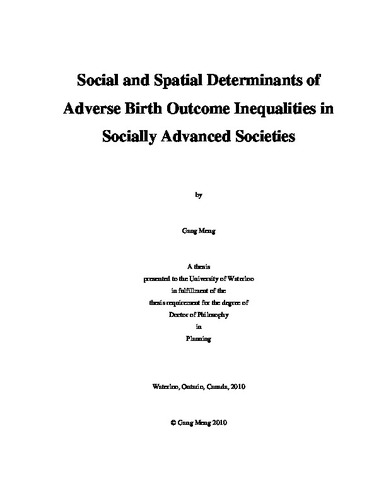UWSpace will be migrating to a new version of its software from July 29th to August 1st. UWSpace will be offline for all UW community members during this time.
Social and Spatial Determinants of Adverse Birth Outcome Inequalities in Socially Advanced Societies
| dc.contributor.author | Meng, Gang | |
| dc.date.accessioned | 2010-10-27 17:02:44 (GMT) | |
| dc.date.available | 2010-10-27 17:02:44 (GMT) | |
| dc.date.issued | 2010-10-27T17:02:44Z | |
| dc.date.submitted | 2010 | |
| dc.identifier.uri | http://hdl.handle.net/10012/5607 | |
| dc.description.abstract | The incidence of adverse birth outcomes, such as low birth weight and preterm births, has steadily risen in recent years in Canada. Despite the fact that numerous individual and neighbourhood risk factors for low birth weight and preterm births have been identified and various person-oriented intervention strategies have been implemented, uncertainties still exist concerning the role that place and space play in determining adverse birth outcomes. In order to succeed in producing community-oriented health policy and planning guidelines to reduce both the occurrence and inequalities of adverse birth outcomes, the research presented in this thesis provides an approach to examining the pathways of various socio-economic, environmental, and psycho-social risks to LBW and preterm births. Using a modified multilevel binary-outcome mediational analysis method, case studies are conducted within three public health units in Ontario, namely the Wellington-Dufferin-Guelph Health Unit, the Windsor-Essex County Health Unit, and the Halton Region Health Unit. Different pathways are investigated given the available data and the theoretical assumptions of three health inequality pathway models, namely the behavioural model, the psycho-social model, and the materialist model, and the geographical and planning perspectives of health inequalities. A local spatial analysis process is also used to identify spatial clusters of incidence and to assess possible associated reasons in order to support public health polices and planning in community-oriented health interventions. Using Bayesian spatial hierarchical analysis and spatial clustering analysis, local clustering of high risks of adverse birth outcomes and spatial variations of associated individual risks within the study areas are identified. The analysis is framed around five hypotheses that examine personal vs. spatial, compositional vs. contextual, psycho-social vs. material, personal vs. cultural, and global vs. local effects on the determinants of adverse birth outcomes. The results of testing these hypotheses provide evidence to assist with multi-component multi-level community-oriented interventions. Possible improvements of current prenatal care policies and programs to reduce the spatial and social inequalities of adverse birth outcomes are suggested. Potential improvements, including early stage prenatal health education, local healthy food provision, and cross-sector interventions such as the combination of social mixing strategies with bottom-up community-based health promotion programs, are also suggested. | en |
| dc.language.iso | en | en |
| dc.publisher | University of Waterloo | en |
| dc.subject | health inequalities | en |
| dc.subject | adverse birth outcomes | en |
| dc.subject | health determinants | en |
| dc.subject | multi-level spatial modeling | en |
| dc.title | Social and Spatial Determinants of Adverse Birth Outcome Inequalities in Socially Advanced Societies | en |
| dc.type | Doctoral Thesis | en |
| dc.pending | false | en |
| dc.subject.program | Planning | en |
| uws-etd.degree.department | Planning | en |
| uws-etd.degree | Doctor of Philosophy | en |
| uws.typeOfResource | Text | en |
| uws.peerReviewStatus | Unreviewed | en |
| uws.scholarLevel | Graduate | en |

